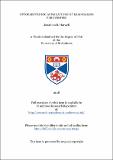Optoelectronic applications of lead halide perovskites
Abstract
Hybrid perovskites are a new class of semiconductor which have proven to be an ideal material for
making thin film solar cells. They have the advantages of flexibility, low cost, and easy processing,
whilst achieving efficiencies competitive with monocrystalline silicon. Many of the properties which
make them ideal for solar cells are also applicable to light emitting devices, and there is now
increasing interest in their application for light emitting diodes (LEDs) and lasers. This thesis aims to
use a range of novel spectroscopy techniques to investigate the origin of these favourable
properties, and to exploit these properties to produce high performance distributed feedback lasers.
A detailed understanding of the origins of the excellent properties of hybrid perovskites is of crucial
importance in the search for new variations with improved performance or lowered toxicity. This
thesis uses Kelvin probe, air photoemission, and resonant ultrasound spectroscopy to probe deeply
into the underlying physics of hybrid perovskite single crystals and devices. Using these techniques,
we are able to produce detailed maps of the energy levels in a common perovskite solar cell, and we
also gain strong insight into the underlying strains and instabilities in the perovskite structure that
give rise to their elastic properties.
The strong light emission of hybrid perovskites is then exploited to produce high quality distributed
feedback lasers emitting in the green and infrared part of the spectrum. These lasers are observed to
have superior stability, good thresholds, and many interesting beam parameters owing to their high
refractive index. We explore a wide range of processing methods in order to achieve the lowest
lasing threshold and the best stability. Finally, we investigate the properties of low dimensional
perovskites and investigate their potential in optoelectronic applications.
Type
Thesis, PhD Doctor of Philosophy
Collections
Description of related resources
Optoelectronic applications of lead halide perovskites (thesis data) Harwell, J.R., University of St Andrews, DOI: https://doi.org/10.17630/fa576f47-27ef-4610-baf5-56893d646329Related resources
https://doi.org/10.17630/fa576f47-27ef-4610-baf5-56893d646329Items in the St Andrews Research Repository are protected by copyright, with all rights reserved, unless otherwise indicated.

